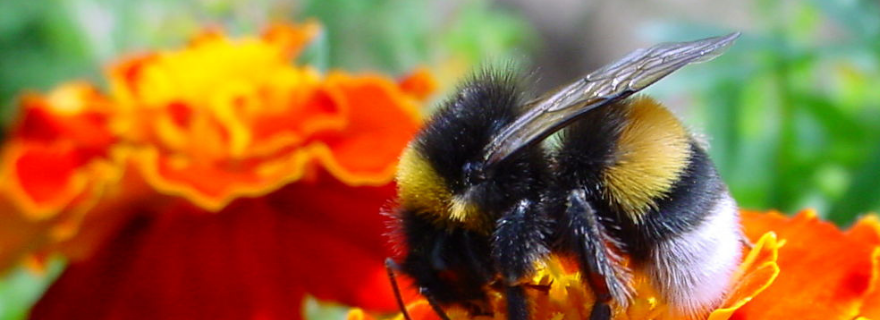[printfriendly]
[su_pullquote align=right] Bumblebees are native to Florida but not seen as often as European honeybees. [/su_pullquote]
Honey bees get all the credit for pollinating our food crops but native bees are as important – maybe more important since European bees are threatened with multiple diseases.

Florida has more than 300 types of native bees – most are solitary bees that live alone, not in a hive that produces honey. Like many other Florida natives, they’re fighting the impact of pesticides and losing habitat to housing developments. (Some experts even question whether they’re losing the competition for food with European bees.)
But unlike so many issues facing our planet today, nearly everyone can do something to help native bees, says Jonathan Elmquist, a research technician at the University of Florida and unofficial native bee expert. Building a bee house can be as easy as cutting bamboo in different widths to drilling wood with holes for them to burrow in – or as simple as filling a can with paper straws.

If you want to try your hand at building a native bee house, use paper straws – not plastic that doesn’t breathe. Size and length don’t matter, he said. Cut them to fit the length of your container, leaving a lip at the edge to protect them from direct rain. Leave the bottom of the can closed, and hang it so it faces the south to collect sunlight during winter months.
Only about 30% of native bees live in bee houses, but others need bare soil to survive. Elmquist recommends finding a spot about a yard wide in an out-of-the-way location and removing all sod, weeds and mulch.
“That’s habitat that’s often missing in suburban settings – bare land where solitary bees can dig holes, he adds. “Native bees aren’t as obvious as ants — in fact, they’re pretty inconspicuous unless you see them coming or going.”

Research on native bees hasn’t had the same priority as European bees because they’re not recognized for their commercial importance, but that may be changing. Along with reports from citizen scientists on native bee populations, a Cornell researcher has shown that native bees are far more effective pollinators than European bees.
“Honeybees are more interested in the nectar. They don’t really want the pollen if they can avoid it. The wild, native bees are mostly pollen collectors,” said Bryan Danforth. “They are collecting the pollen to take back to their nests.”
They are also more plentiful than once thought too. In 25 surveyed orchards near Ithaca and Lake Ontario, Danforth and his team expected to find 40 to 50 native bee species, and they found almost 100. UF has identified at least 300 native species in Florida – and there may be more because they’re harder to find and identify than a European honeybee.

“We know that native bees like the squash bee are active in Florida,” Elmquist said. “We’re probably more likely to see them in our backyards than a commercial farm, because they burrow in the ground that most homeowners don’t cover but is more likely to be protected in a commercial operation.”
Some native bees – like the squash bee – are very specific in their feeding habits while others can be found only on native flowers, he adds. In either case, they’re less likely to sting than their European counterparts. “Bees sting because they’re protecting their colony – native bees are generally solitary, so they don’t have a colony to protect. It’s easier for them to fly away than sting.”
Learn more:
A UF report on the most common native bees, their habitat and the foods they prefer
For more information on specific bees (native or not), visit UF’s Featured Creatures website, run by the Entomology and Nematology Department.
Native bees are so unknown that scientists just discovered 49 new species in a preserve in Utah.
While most of us think of fuzzy bees with black stripes as the only bumblebee, dozens of species are found across the country. Visit https://www.bumblebeewatch.org/ and participate in their citizen scientist program to report sightings in your yard.
It’s not necessarily the right time of year to start planting g food for native bees, but www.pollinator.org offers tips for plants that do well in all parts of the country. (Bay Soundings will run another story once it warms up enough to start putting seeds in the ground.)
Bee houses come in all kinds of shapes and sizes. For easy construction, check out https://honeybeesuite.com/paper-straws-for-native-bee/.
To build a more durable bee house from wood, see https://www.nwf.org/Garden-For-Wildlife/Young/Build-a-Bee-House.aspx
For directions on bamboo bee houses, visit which also includes information on other bee houses and how to maintain them.
And finally, for the truly crafty people, check out this Pinterest page with more ideas than you could imagine.
By Vicki Parsons, originally published Dec. 18, 2018.
[su_divider]
